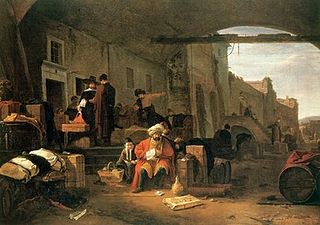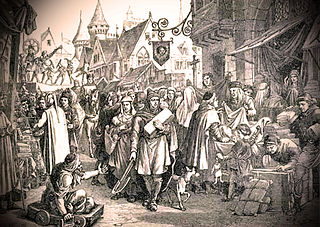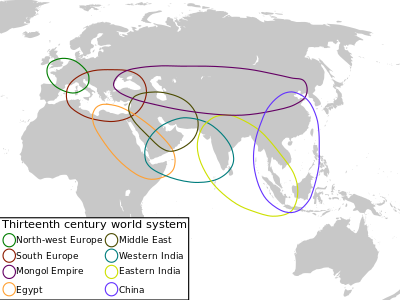
Capitalism is an economic system based on the private ownership of the means of production and their operation for profit. Central characteristics of capitalism include capital accumulation, competitive markets, price systems, private property, property rights recognition, voluntary exchange, and wage labor. In a market economy, decision-making and investments are determined by owners of wealth, property, or ability to maneuver capital or production ability in capital and financial markets—whereas prices and the distribution of goods and services are mainly determined by competition in goods and services markets.

A merchant is a person who trades in commodities produced by other people, especially one who trades with foreign countries. Historically, a merchant is anyone who is involved in business or trade. Merchants have operated for as long as industry, commerce, and trade have existed. In 16th-century Europe, two different terms for merchants emerged: meerseniers referred to local traders and koopman referred to merchants who operated on a global stage, importing and exporting goods over vast distances and offering added-value services such as credit and finance.
Commerce is the large-scale organized system of activities, functions, procedures and institutions that directly or indirectly contribute to the smooth, unhindered distribution and transfer of goods and services on a substantial scale and at the right time, place, quantity, quality and price through various channels from the original producers to the final consumers within local, regional, national or international economies. The diversity in the distribution of natural resources, differences of human needs and wants, and division of labour along with comparative advantage are the principal factors that give rise to commercial exchanges.

Hegemony is the political, economic, and military predominance of one state over other states. Hegemony can be regional or global.

The spice trade involved historical civilizations in Asia, Northeast Africa and Europe. Spices such as cinnamon, cassia, cardamom, ginger, pepper, nutmeg, star anise, clove, and turmeric were known and used in antiquity and traded in the Eastern World. These spices found their way into the Near East before the beginning of the Christian era, with fantastic tales hiding their true sources.

The Age of Discovery or the Age of Exploration, part of the early modern period and largely overlapping with the Age of Sail, was a period from approximately the 15th century to the 17th century, during which seafarers from a number of European countries explored, colonized, and conquered regions across the globe. The extensive overseas exploration, particularly the European colonisation of the Americas, with the Spanish and Portuguese at the forefront, later joined by the Dutch, English, and French, marked an increased adoption of colonialism as a government policy in several European states. As such, it is sometimes synonymous with the first wave of European colonization.

The Pax Mongolica, less often known as Pax Tatarica, is a historiographical term modeled after the original phrase Pax Romana which describes the stabilizing effects of the conquests of the Mongol Empire on the social, cultural and economic life of the inhabitants of the vast Eurasian territory that the Mongols conquered in the 13th and 14th centuries. The term is used to describe the eased communication and commerce the unified administration helped to create and the period of relative peace that followed the Mongols' vast conquests.

In world systems theory, the core countries are the industrialized capitalist or imperialist countries, which depend on appropriation from peripheral countries and semi-peripheral countries. Core countries control and benefit from the global market. They are usually recognized as wealthy states with a wide variety of resources and are in a favorable location compared to other states. They have strong state institutions, a powerful military and powerful global political alliances.

World-systems theory is a multidisciplinary approach to world history and social change which emphasizes the world-system as the primary unit of social analysis.
The history of capitalism is diverse and the concept of capitalism has many debated roots. The history of the past 500 years is concerned with the development of capitalism in its various forms. Capital accumulated by a variety of methods, at a variety of scales, became associated with much variation in the concentration of wealth and economic power. Capitalism gradually became the dominant economic system throughout the world.

An economy is an area of the production, distribution and trade, as well as consumption of goods and services. In general, it is defined as a social domain that emphasize the practices, discourses, and material expressions associated with the production, use, and management of scarce resources. A given economy is a set of processes that involves its culture, values, education, technological evolution, history, social organization, political structure, legal systems, and natural resources as main factors. These factors give context, content, and set the conditions and parameters in which an economy functions. In other words, the economic domain is a social domain of interrelated human practices and transactions that does not stand alone.
Janet Lippman Abu-Lughod was an American sociologist who made major contributions to world-systems theory and urban sociology.

The historical origins of globalization are the subject of ongoing debate. Though many scholars situate the origins of globalization in the modern era, others regard it as a phenomenon with a long history, dating back thousands of years. The period in the history of globalization roughly spanning the years between 1600 and 1800 is in turn known as the proto-globalization.

The Champagne fairs were an annual cycle of trade fairs which flourished in different towns of the County of Champagne in Northeastern France in the 12th and 13th centuries, originating in local agricultural and stock fairs. Each fair lasted about 2 to 3 weeks. The Champagne fairs, sited on ancient land routes and largely self-regulated through the development of the Lex mercatoria, became an important engine in the reviving economic history of medieval Europe, "veritable nerve centers" serving as a premier market for textiles, leather, fur, and spices. At their height, in the late 12th and the 13th century, the fairs linked the cloth-producing cities of the Low Countries with the Italian dyeing and exporting centers, with Genoa in the lead, dominating the commercial and banking relations operating at the frontier region between the north and the Mediterranean. The Champagne fairs were one of the earliest manifestations of a linked European economy, a characteristic of the High Middle Ages.

In world systems theory, the periphery countries are those that are less developed than the semi-periphery and core countries. These countries usually receive a disproportionately small share of global wealth. They have weak state institutions and are dependent on — and, according to some, exploited by — more developed countries. These countries are usually behind because of obstacles such as lack of technology, unstable government, and poor education and health systems. In some instances, the exploitation of periphery countries' agriculture, cheap labor, and natural resources aid core countries in remaining dominant. This is best described by dependency theory, which is one theory on how globalization can affect the world and the countries in it. It is, however, possible for periphery countries to rise out of their status and move into semi-periphery or core status. This can be done by doing things such as industrializing, stabilizing the government and political climate, etc.

In world-systems theory, the semi-periphery countries are the industrializing, mostly capitalist countries which are positioned between the periphery and core countries. Semi-periphery countries have organizational characteristics of both core countries and periphery countries and are often geographically located between core and peripheral regions as well as between two or more competing core regions. Semi-periphery regions play a major role in mediating economic, political, and social activities that link core and peripheral areas.

The Eastern Origins of Western Civilisation, written by the political scientist John M. Hobson in 2004, is a book that argues against the historical theory of the rise of the West after 1492 as a "virgin birth", but rather as a product of Western interactions with a more technically and socially advanced Eastern civilization.
Proto-globalization or early modern globalization is a period of the history of globalization roughly spanning the years between 1600 and 1800, following the period of archaic globalization. First introduced by historians A. G. Hopkins and Christopher Bayly, the term describes the phase of increasing trade links and cultural exchange that characterized the period immediately preceding the advent of so-called "modern globalization" in the 19th century.
A world-system is a socioeconomic system, under systems theory, that encompasses part or all of the globe, detailing the aggregate structural result of the sum of the interactions between polities. World-systems are usually larger than single states, but do not have to be global. The Westphalian System is the preeminent world-system operating in the contemporary world, denoting the system of sovereign states and nation-states produced by the Westphalian Treaties in 1648. Several world-systems can coexist, provided that they have little or no interaction with one another. Where such interactions becomes significant, separate world-systems merge into a new, larger world-system. Through the process of globalization, the modern world has reached the state of one dominant world-system, but in human history there have been periods where separate world-systems existed simultaneously, according to Janet Abu-Lughod. The most well-known version of the world-system approach has been developed by Immanuel Wallerstein. A world-system is a crucial element of the world-system theory, a multidisciplinary, macro-scale approach to world history and social change.
Political economy in anthropology is the application of the theories and methods of historical materialism to the traditional concerns of anthropology, including but not limited to non-capitalist societies. Political economy introduced questions of history and colonialism to ahistorical anthropological theories of social structure and culture. Most anthropologists moved away from modes of production analysis typical of structural Marxism, and focused instead on the complex historical relations of class, culture and hegemony in regions undergoing complex colonial and capitalist transitions in the emerging world system.












